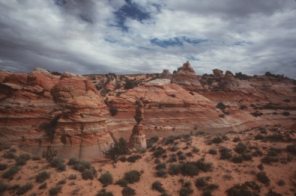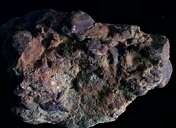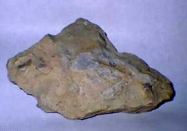14.5.3: Sedimentary Rocks
- Page ID
- 16451
\( \newcommand{\vecs}[1]{\overset { \scriptstyle \rightharpoonup} {\mathbf{#1}} } \)
\( \newcommand{\vecd}[1]{\overset{-\!-\!\rightharpoonup}{\vphantom{a}\smash {#1}}} \)
\( \newcommand{\id}{\mathrm{id}}\) \( \newcommand{\Span}{\mathrm{span}}\)
( \newcommand{\kernel}{\mathrm{null}\,}\) \( \newcommand{\range}{\mathrm{range}\,}\)
\( \newcommand{\RealPart}{\mathrm{Re}}\) \( \newcommand{\ImaginaryPart}{\mathrm{Im}}\)
\( \newcommand{\Argument}{\mathrm{Arg}}\) \( \newcommand{\norm}[1]{\| #1 \|}\)
\( \newcommand{\inner}[2]{\langle #1, #2 \rangle}\)
\( \newcommand{\Span}{\mathrm{span}}\)
\( \newcommand{\id}{\mathrm{id}}\)
\( \newcommand{\Span}{\mathrm{span}}\)
\( \newcommand{\kernel}{\mathrm{null}\,}\)
\( \newcommand{\range}{\mathrm{range}\,}\)
\( \newcommand{\RealPart}{\mathrm{Re}}\)
\( \newcommand{\ImaginaryPart}{\mathrm{Im}}\)
\( \newcommand{\Argument}{\mathrm{Arg}}\)
\( \newcommand{\norm}[1]{\| #1 \|}\)
\( \newcommand{\inner}[2]{\langle #1, #2 \rangle}\)
\( \newcommand{\Span}{\mathrm{span}}\) \( \newcommand{\AA}{\unicode[.8,0]{x212B}}\)
\( \newcommand{\vectorA}[1]{\vec{#1}} % arrow\)
\( \newcommand{\vectorAt}[1]{\vec{\text{#1}}} % arrow\)
\( \newcommand{\vectorB}[1]{\overset { \scriptstyle \rightharpoonup} {\mathbf{#1}} } \)
\( \newcommand{\vectorC}[1]{\textbf{#1}} \)
\( \newcommand{\vectorD}[1]{\overrightarrow{#1}} \)
\( \newcommand{\vectorDt}[1]{\overrightarrow{\text{#1}}} \)
\( \newcommand{\vectE}[1]{\overset{-\!-\!\rightharpoonup}{\vphantom{a}\smash{\mathbf {#1}}}} \)
\( \newcommand{\vecs}[1]{\overset { \scriptstyle \rightharpoonup} {\mathbf{#1}} } \)
\( \newcommand{\vecd}[1]{\overset{-\!-\!\rightharpoonup}{\vphantom{a}\smash {#1}}} \)
\(\newcommand{\avec}{\mathbf a}\) \(\newcommand{\bvec}{\mathbf b}\) \(\newcommand{\cvec}{\mathbf c}\) \(\newcommand{\dvec}{\mathbf d}\) \(\newcommand{\dtil}{\widetilde{\mathbf d}}\) \(\newcommand{\evec}{\mathbf e}\) \(\newcommand{\fvec}{\mathbf f}\) \(\newcommand{\nvec}{\mathbf n}\) \(\newcommand{\pvec}{\mathbf p}\) \(\newcommand{\qvec}{\mathbf q}\) \(\newcommand{\svec}{\mathbf s}\) \(\newcommand{\tvec}{\mathbf t}\) \(\newcommand{\uvec}{\mathbf u}\) \(\newcommand{\vvec}{\mathbf v}\) \(\newcommand{\wvec}{\mathbf w}\) \(\newcommand{\xvec}{\mathbf x}\) \(\newcommand{\yvec}{\mathbf y}\) \(\newcommand{\zvec}{\mathbf z}\) \(\newcommand{\rvec}{\mathbf r}\) \(\newcommand{\mvec}{\mathbf m}\) \(\newcommand{\zerovec}{\mathbf 0}\) \(\newcommand{\onevec}{\mathbf 1}\) \(\newcommand{\real}{\mathbb R}\) \(\newcommand{\twovec}[2]{\left[\begin{array}{r}#1 \\ #2 \end{array}\right]}\) \(\newcommand{\ctwovec}[2]{\left[\begin{array}{c}#1 \\ #2 \end{array}\right]}\) \(\newcommand{\threevec}[3]{\left[\begin{array}{r}#1 \\ #2 \\ #3 \end{array}\right]}\) \(\newcommand{\cthreevec}[3]{\left[\begin{array}{c}#1 \\ #2 \\ #3 \end{array}\right]}\) \(\newcommand{\fourvec}[4]{\left[\begin{array}{r}#1 \\ #2 \\ #3 \\ #4 \end{array}\right]}\) \(\newcommand{\cfourvec}[4]{\left[\begin{array}{c}#1 \\ #2 \\ #3 \\ #4 \end{array}\right]}\) \(\newcommand{\fivevec}[5]{\left[\begin{array}{r}#1 \\ #2 \\ #3 \\ #4 \\ #5 \\ \end{array}\right]}\) \(\newcommand{\cfivevec}[5]{\left[\begin{array}{c}#1 \\ #2 \\ #3 \\ #4 \\ #5 \\ \end{array}\right]}\) \(\newcommand{\mattwo}[4]{\left[\begin{array}{rr}#1 \amp #2 \\ #3 \amp #4 \\ \end{array}\right]}\) \(\newcommand{\laspan}[1]{\text{Span}\{#1\}}\) \(\newcommand{\bcal}{\cal B}\) \(\newcommand{\ccal}{\cal C}\) \(\newcommand{\scal}{\cal S}\) \(\newcommand{\wcal}{\cal W}\) \(\newcommand{\ecal}{\cal E}\) \(\newcommand{\coords}[2]{\left\{#1\right\}_{#2}}\) \(\newcommand{\gray}[1]{\color{gray}{#1}}\) \(\newcommand{\lgray}[1]{\color{lightgray}{#1}}\) \(\newcommand{\rank}{\operatorname{rank}}\) \(\newcommand{\row}{\text{Row}}\) \(\newcommand{\col}{\text{Col}}\) \(\renewcommand{\row}{\text{Row}}\) \(\newcommand{\nul}{\text{Nul}}\) \(\newcommand{\var}{\text{Var}}\) \(\newcommand{\corr}{\text{corr}}\) \(\newcommand{\len}[1]{\left|#1\right|}\) \(\newcommand{\bbar}{\overline{\bvec}}\) \(\newcommand{\bhat}{\widehat{\bvec}}\) \(\newcommand{\bperp}{\bvec^\perp}\) \(\newcommand{\xhat}{\widehat{\xvec}}\) \(\newcommand{\vhat}{\widehat{\vvec}}\) \(\newcommand{\uhat}{\widehat{\uvec}}\) \(\newcommand{\what}{\widehat{\wvec}}\) \(\newcommand{\Sighat}{\widehat{\Sigma}}\) \(\newcommand{\lt}{<}\) \(\newcommand{\gt}{>}\) \(\newcommand{\amp}{&}\) \(\definecolor{fillinmathshade}{gray}{0.9}\)Sedimentary rocks are those formed from the compaction and cementation of fragments of pre-existing rocks called clasts, or plant and animals remains. The exogenic processes of weathering and erosion create the raw materials for sedimentary rocks. Earth material is loosened and moved from higher to lower elevations where it is deposited as transportation agents like water, wind or gravity lose their energy to move sediment. Streams and rivers transport sediment to lakes or oceans, or deposits it on nearby floodplains where it accumulates. On land, clastic sediments consist mainly of large boulders, cobbles, gravel, sand, and silt. On the continental shelves at the margin of continents, marine sediment is largely sand, silt, and clay. At the outer shelves and on the ocean floor, clays and chemically precipitated calcium carbonate and the remains of tiny marine animals accumulate.

As layers of sediment accumulate to great thickness, they are compacted and begin to harden into sedimentary rock. Each layer they form is called a bed or stratum, the process by which this occurs is called stratification. The separation between each bed is called a bedding plane and signifies a cessation of deposition at that location for a period of time. Beds can vary horizontally due to differences in the energy conditions and distance from the origin of the sediments. For instance, a bed may change from a conglomerate of cemented gravel, to compacted silt called siltstone, and finally to shale which is cemented clay, indicating the decreasing power of water to transport these different size materials from away from their source. Generally speaking, if the layers have not been disturbed, the oldest layers are at the bottom. Often there is a cementing agent that holds the materials together. Because many sedimentary rocks are formed from fragments of rocks, they are weaker than igneous or metamorphic rocks.
Types of sedimentary rocks
Sedimentary rocks are divided into two groups, clastic or detrital, and nonclastic or chemical. Among the chemical sedimentary rocks are those that are "biologic" in origin like coal. The clastic sedimentary rocks form from the compaction of rock fragments, while the chemical sedimentary rocks form by the precipitation of elements. Sandstone is a common clastic sedimentary rock formed by the compaction and cementation of sand (quartz grains). Conglomerate is another clastic sedimentary rock formed by the cementation of rounded boulders, cobbles, and pebbles. On the other hand, breccia forms from angular boulders, cobbles, and pebbles. Shale forms from the compaction of clays, while siltstone (mudstone) forms from the compaction of silt.



You are probably familiar with several of the nonclastic sedimentary rocks. Limestone is composed of precipitated calcium carbonate. Limestone sometimes contains visible shells of marine organisms that have accumulates on the ocean floor. Dolomite is a calcium-magnesium carbonate rock that forms as a chemical precipitate or from the alteration of limestone. Limestone is very easily weathered in warm and moist climates to create karst topography.
Coal is considered a sedimentary rock. Some might classify it as a biologic sedimentary rock as it forms from the compaction and alteration of accumulated plant matter. Coal is classified into one of three types depending on its level of development. Lignite is a soft, brown coal and is the least developed form. One might think of it as an intermediate step between peat and coal. Bituminous coal, also called soft coal though harder than lignite, is a product of deep burial and compaction. Anthracite is the hardest and most developed or pure form of coal. Anthracite forms when bituminous coal is metamorphosed in regions that have undergone mountain building. Anthracite is the most valued form of coal for its heat generating capacity and low sulfur content.



